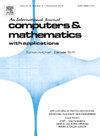Spatiotemporal numerical simulation of breast cancer tumors in one-dimensional nonlinear moving boundary models via temporal-spatial spectral collocation method
IF 2.9
2区 数学
Q1 MATHEMATICS, APPLIED
引用次数: 0
Abstract
In this research article, we have simulated the solutions of three types of (classical) moving boundary models in ductal carcinoma in situ by an efficient temporal-spatial spectral collocation method. In all of these three classical models, the associated fixed (spatial) boundary equations are localized by the numerical scheme. In the numerical scheme, Laguerre polynomials and Hermite polynomials are implemented to approximate the temporal and spatial variables (of unknown solutions), respectively. Then, as a generalization of the first classical model, we have considered a space-fractional moving boundary model and then transformed it, again, to the corresponding fixed boundary space-fractional equation for a straightforward discretization. Due to the impossibility of transforming of the time-fractional moving boundary model into its fixed boundary variant, we localized the time-fractional moving boundary model directly by the proposed method. The results in this category are also very satisfactory and the accuracy is again in a spectral rate. Moreover, (temporal) multi-step version of our method is applied for the considered models and the results are very accurate with respect to the single-step one, especially when the boundary of tumor is diverging in practice. In this regard, an adaptive strategy is connected to the temporal multi-step approach for a better simulation. Extensive test problems are provided to verify the accuracy of the method, with full consideration given to iterative tools for solving the final system of nonlinear algebraic equations.
在这篇研究文章中,我们采用高效的时空谱配位法模拟了导管原位癌中三种(经典)移动边界模型的解。在这三种经典模型中,相关的固定(空间)边界方程都通过数值方案进行了定位。在数值方案中,拉盖尔多项式和赫米特多项式分别用于逼近(未知解的)时间变量和空间变量。然后,作为对第一个经典模型的概括,我们考虑了空间分数移动边界模型,并再次将其转换为相应的固定边界空间分数方程,以实现直接离散化。由于不可能将时间分数移动边界模型转化为其固定边界变体,我们直接用提出的方法对时间分数移动边界模型进行了局部化。这一类的结果也非常令人满意,精度再次达到了频谱率。此外,我们对所考虑的模型采用了(时间)多步骤方法,与单步骤方法相比,结果非常准确,尤其是当肿瘤边界在实践中发散时。在这方面,自适应策略与时间多步骤方法相结合,以获得更好的模拟效果。提供了大量的测试问题来验证该方法的准确性,并充分考虑了迭代工具来解决最终的非线性代数方程系统。
本文章由计算机程序翻译,如有差异,请以英文原文为准。
求助全文
约1分钟内获得全文
求助全文
来源期刊

Computers & Mathematics with Applications
工程技术-计算机:跨学科应用
CiteScore
5.10
自引率
10.30%
发文量
396
审稿时长
9.9 weeks
期刊介绍:
Computers & Mathematics with Applications provides a medium of exchange for those engaged in fields contributing to building successful simulations for science and engineering using Partial Differential Equations (PDEs).
 求助内容:
求助内容: 应助结果提醒方式:
应助结果提醒方式:


